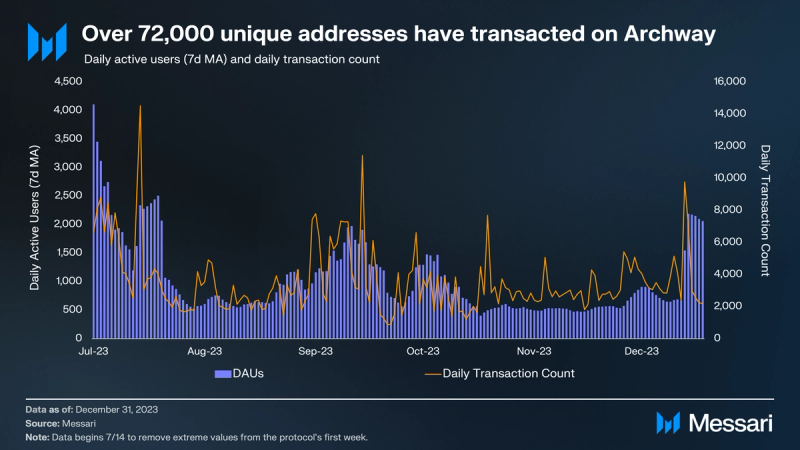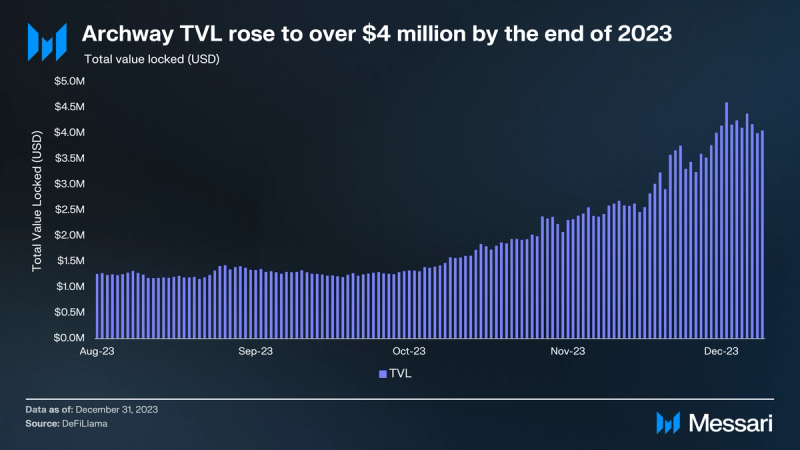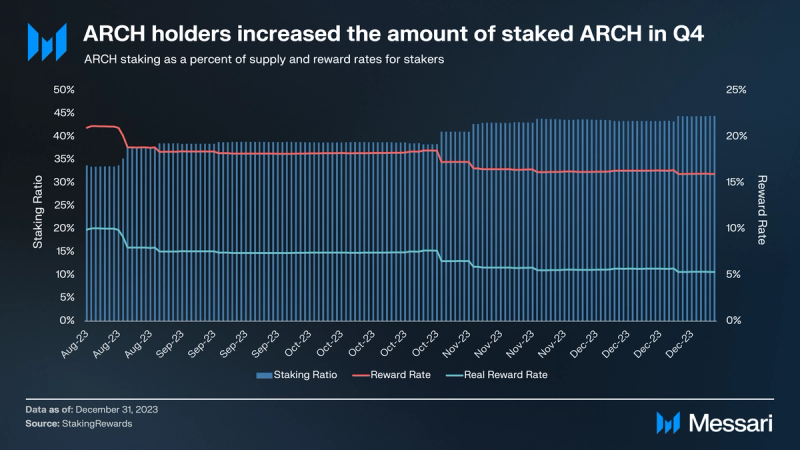Key Insights
- In Q4, those who deployed contracts earned more than $11,000 worth of ARCH tokens, benefiting from a 231% surge in ARCH price. By the end of the year, almost $2 million was allocated to the Dapp Treasury and earmarked for distribution among developers.
- The number of unique addresses to have deployed contracts on Archway grew from 114 to 167 by the end of Q4, with 263 contracts deployed since genesis.
- The staking ratio increased to 44.5% by the end of Q4, and the chain was consistently supported by at least 99 validators.
- The infrastructure and ecosystem around the Archway chain grew in the fourth quarter, with multiple wallet integrations, bridges, and cross-chain protocols adding functionality. Users executed over 1 million transactions on Archway in under six months.
Primer
Archway (ARCH) is a Cosmos-native Layer-1 blockchain designed to redefine the economic model for decentralized applications (dApps). Archway is positioning itself both to facilitate the growth of the app chain ecosystem, as well as to compete as a Layer-1 on which to build and launch heavily utilized dapps. By leveraging the Cosmos ecosystem’s Inter-Blockchain Communication (IBC) protocol, Archway ensures seamless interoperability across over 50 chains, enhancing the reach and functionality of deployed dApps.
Archway also has a unique rewards system. Unlike traditional Layer-1 economic models, Archway provides direct compensation to dApp developers through gas fee rebates, inflationary rewards share, and smart contract premiums. Unlike other platforms, entrepreneurs and developers building on Archway can receive a stake in the growth and governance of the protocol itself. This model aims to foster a sustainable and thriving development environment.
Archway’s technical foundation is built on the Cosmos SDK. It features a complete implementation of CosmWasm, enabling dApps to be developed in multiple programming languages. The blockchain is secured by the Tendermint consensus algorithm, known for its speed, security, and environmental efficiency. With these capabilities, Archway positions itself as a leading platform for developers seeking to build economically viable dApps within the Cosmos ecosystem and beyond.
Website / X (Twitter) / Telegram
Key Metrics

Performance Analysis

Archway pays developers who build and deploy contracts on the chain which users pay to use. As a result, over $18,000 was paid to contract deployers in 2023, with 63% of those rewards coming in the fourth quarter. The USD value of the rewards paid to contract deployers increased, primarily due to the 231% rise in token price. In ARCH terms, deployers earned just over 64,000 ARCH in Q4 after earning just under 82,000 ARCH in Q3. 25% of ARCH inflation goes to developers, but most of the rewards are sent to the Dapp Treasury at the moment. As of writing, the community is discussing different ways to properly distribute the Dapp Treasury’s holdings to developers. Sitting at near $2 million, the ARCH in the Dapp Treasury is almost a 100x the amount of ARCH to be paid to developers compared to what has already been delivered.
In Q4’23, 51 unique addresses launched 79 new contracts in Q4’23, increasing the total number of contracts to 263 unique deployments at year’s end from 167 unique deployer addresses. The trend in new addresses deploying contracts was not as clear as payouts, with 20 addresses deploying contracts in October, 17 in November, and 14 in December. There could be a lag between developers earning for their work and attracting new developers who have seen the new mechanism be tested.

User activity on Archway consistently increased in the fourth quarter. Transactions in December peaked with over 3,700 transactions per day and DAUs climbed to over 1,000 per day. DAUs measures the number of unique transaction signers on each day. User activity tends to lag behind developer activity, so as more apps are launched on the chain, user metrics should reflect that growth.

Archway’s TVL is almost entirely in the largest DEX on the chain, Astrovault. Most pairs on Astrovault are denominated in ARCH, which draws in TVL and also drives demand and usage for ARCH early in the chain’s life. This is typical of chain launches as most of the liquidity early on is in the native token. As new apps launch, assets should easily flow to the Archway chain – especially considering the IBC connections. Liquid Finance, a non-custodial liquid staking protocol on Archway, was the second largest protocol by TVL with over $367,000 at year end.

The staking ratio on Archway has stayed over 40% since launch. The chain consistently fills the 100 active validators available using the Tendermint consensus, and they have been rewarded for validating the chain. While inflation is currently set at 10% by governance, half of the gas fees are burned. Given the low usage due to newly launched apps, less than 100,000 ARCH have been burned.
Key Developments
Protocol Upgrades and Integrations
- October 25: The next major upgrade to version 5, indicating ongoing development and improvement of the platform.
- November 27: SubQuery indexes the Archway blockchain, enabling improvements in data querying and blockchain analytics.
- December 11: Kyve integration enables syncing to any Archway height in under 2 minutes.
- December 13: ArchID launches support for Metamask, powered by Leap’s Cosmos snap.
- December 21: xCall integration goes live on Archway, uniting Cosmos and IBC to the ICON ecosystem.
Partnerships and Collaboration
- October 5: Leap wallet official partnership announced.
- October 9: Native USDC brought to Archway via Noble, broadening the spectrum of available stablecoins and enhancing usability.
- October 24: Partnership with Labs_electron to bring ZK-IBC, enhancing privacy and interoperability features.
- October 25: Integration with Babylon, expanding ecosystem and interoperability.
- October 30: Station Wallet integration, improving user experience and wallet accessibility.
- November 7: Support from MathWallet, expanding wallet compatibility and user reach.
- November 28: Onboarding of ARCH on Gravity Bridge, indicating expansion in bridge and cross-chain functionalities.
- December 4: Construction of Nomos Multisig on Archway, signifying advancements in multisignature wallet functionality and security. DAOs on the chain are now entirely supported by Nomos.
- December 8: XDEFI wallet integration; user-friendly wallet with access to over 30 decentralized ecosystems.
- December 13: Andromeda partnership and hackathon to build on Archway using aOS.
- December 18: Balanced launches on Archway, bringing cross-chain swaps to the L1.
- December 18: Nomos integrates ArchID directly into its multisig.
- December 21: ARCH listed on Crypto.com.
Audits and Security
- November 10: Completion and passing of the third audit by Informal Systems, focusing on vesting and withdrawal smart contracts, enhancing trust and security.
Community and Governance
- November 23: Opening of Archway delegation cycle 2, allowing validators to compete for delegation from the Foundation, fostering a healthy validator ecosystem.
- November 27: Announcement of winners in the Quadratic funding round, promoting community-driven projects and funding allocation.
- November / December: Initial launch of regional Archway communities and global events — Nigeria, The Philippines, Colombia, Portugal, and India.
- December 1: Proposal 32 passed, leading to the restructuring of the liquidity council and budget, showing active community governance and adaptability.
Closing Summary
Archway completed its first five months with hundreds of addresses deploying contracts and developers receiving nearly $18,000, not including nearly $2 million currently being sent to the Dapp Treasury awaiting distribution. Usage has been steady with over 3,700 transactions per day in December, despite a small application environment. TVL on Archway’s largest DEX, Astrovault, rose to over $4 million at the end of the year. More infrastructure is being built around Archway including wallet integrations, cross-chain swaps, and indexing the chain. The economic model has successfully attracted new addresses that are deploying contracts on the chain daily, which should encourage increased usage in 2024.



















